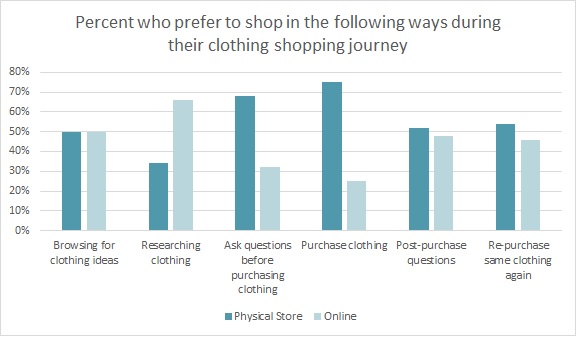When you go to Fashion Week, the talk is all about what’s trending in colors, cuts, hemlines, and finishes. When you go to retail seminars, it’s about data. And how artificial intelligence (AI), machine learning, and even augmented reality (AR) is moving the needle in transforming the customer experience and the future of the commerce. While these tech-oriented terms might not have the headline appeal of Philipp Plein’s cabaret runway show, they are defining the future of retail.[quote]
SAP’s Lori Mitchell-Keller, global general manager, consumer industries, says AI and AR will help retailers provide not only a seamless shopping experience, but convenience in today’s fast-paced economy.
“With personalized recommendations, consumers get the best of both worlds,” Mitchell-Keller says. “Consumers continue to respond well to targeted recommendations through email, text, and push notifications, and, according to Accenture, 65 percent are more likely to shop at a retailer that knows their purchase history and offers relevant recommendations.”
At the recent SAP Retail Executive Forum in New York, Accenture’s Vish Ganapathy, chief technology officer, spoke about “retail with a purpose,” and how AI will play a part.
“We think AI is going to significantly change how you work,” Ganapathy stated, pointing out that the role of the merchant will change in areas that include PLM (product lifecycle management) and assortments. He says a lot of brands are using AI now for applications like voice recognition, which is used for chatbots. “We believe those things are barely scratching the surface. We are investing a lot of our time and effort teaching machines the new ways of the back office, in teaching them how to be in positions of support agents for the GMM and the DMM*, and to make better bets on the assortment, store clustering and improving inventory.”
Consumers provide this data through their regular online searches and their actual in-store purchases, all of which can be gathered by stores and brands. Most consumers (66 percent) research apparel online, but the majority (75 percent) prefer to actually buy their clothes in a physical store, according to the Cotton Incorporated Lifestyle Monitor™ Survey.
About 4 in 10 consumers typically research clothing online through retailer or brand websites (41 percent), according to the Monitor™ research, followed by search engines (26 percent) and brand emails (19 percent).
All of this data can pinpoint where consumer interest lies, and can tell stores and brands the directions they should take going forward.
Luke Starbuck, vice president of marketing for Linc, a customer care automation company, says that while the retail industry has generally been slow to adopt AI, it’s no longer denying its importance and impact on growth.
“Only 7.7 percent of surveyed retailers confirm AI currently plays a regular role in their customer service programs, but 34 percent have begun experimenting with customer-facing AI trials or pilots,” Starbuck says. “And 87 percent expect to increase their use of AI in customer service over the next 24 months. This is an accelerating adoption curve that clearly shows the importance of AI in retail.”
AI is defined broadly as the ability of computers to mimic human thinking and logic. Meanwhile, machine learning is considered a subset of AI, where the use of algorithms that adapt to change allow computers to learn from data without being programmed.
SAP’s Mitchell-Keller says that among other things, AI can be used to provide personalized product recommendations based on each customer’s purchase history and interests, use chatbots to drive intelligent conversations with customers, and leverage pricing engines to offer tailored pricing options and discounts. It can also be used to support in-store merchandizing by telling people what’s missing, comparing sales to shelf space, and accelerating shelf replenishment by automating reorders.
Artificial intelligence that makes a store more responsive or helps provide more personalized recommendations could also help increase the comfort level of consumers who are wary of online shopping or working with retail chatbots. Currently, more than half of all consumers say they are very comfortable researching (60 percent) and browsing (57 percent) for clothing online, but less than half are very comfortable with buying online (41 percent), returning an online purchase (32 percent), or having an online chat (27 percent), according to Monitor™ research.

AI, as well as AR, could also provide consumers with information or promotions for items they’re specifically interested in. Even when shopping in-store, close to 1 in 2 consumers say they always or usually search for coupons (49 percent) and compare prices (49 percent) on their mobile device, according to Monitor™ data, followed by reading customer reviews (46 percent) and researching product details (33 percent).
The use of AR in retail is also on the rise. For instance, retailers like Uniqlo, Gap, and Adidas have used LCD screens in smart fitting rooms that let consumers “try on” different outfits without actually pulling different apparel items on and off.
More recently, Mastercard collaborated with ODG (Osterhout Design Group) and Qualcomm to create an iris authentication system to be used with its Masterpass and Identity Check Mobile payment systems. Mastercards new AR experience allows shoppers to view digital representations and learn about products before they commit to a purchase. They can also see additional options not available in the physical location and get instant recommendations or other information relevant. When done shopping, users can pay for items using Masterpass, which will first authenticate the user’s iris through Qualcomm Technologies’ iris authentication. The shopper then selects a card from their Masterpass-enabled wallet and completes the purchase by selecting the on-screen Masterpass button. Items can be taken home from the store or shipped, depending on availability.
Mastercard’s Sherri Haymond, executive vice president, digital partnerships, says, “As the physical and digital worlds blend together, we are focused on developing solutions that provide merchants with the ability to accept payments across all technology platforms possible — in-store, in-app, online, and in AR and VR** — to help drive how people will experience shopping and payments in the future.”
*General Merchandise Manager and Divisional Merchandise Manager
**Virtual reality
